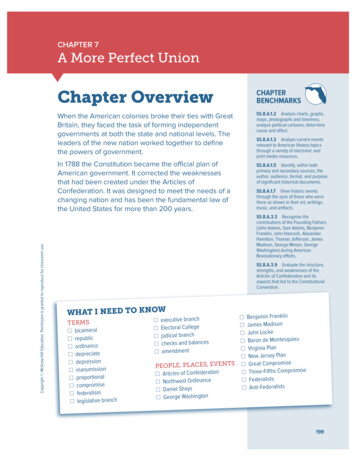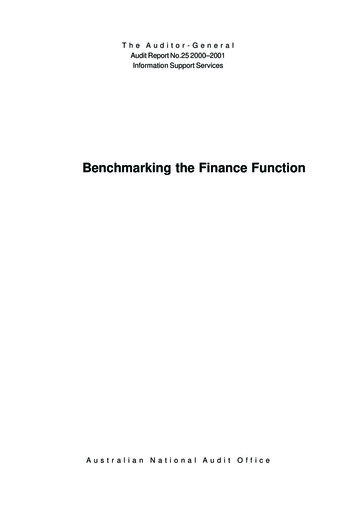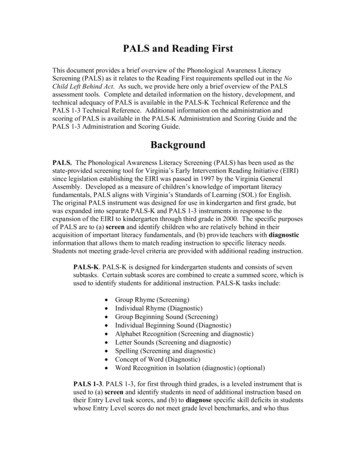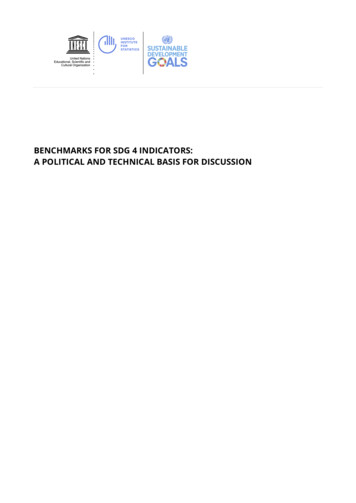
Transcription
NameDateClassCHAPTER 7Copyright McGraw-Hill Education. Permission is granted to reproduce for classroom use.A More Perfect UnionChapter OverviewCHAPTERBENCHMARKSWhen the American colonies broke their ties with GreatBritain, they faced the task of forming independentgovernments at both the state and national levels. Theleaders of the new nation worked together to definethe powers of government.SS.8.A.1.2 Analyze charts, graphs,maps, photographs and timelines;analyze political cartoons; determinecause and effect.In 1788 the Constitution became the official plan ofAmerican government. It corrected the weaknessesthat had been created under the Articles ofConfederation. It was designed to meet the needs of achanging nation and has been the fundamental law ofthe United States for more than 200 years.SS.8.A.1.5 Identify, within bothprimary and secondary sources, theauthor, audience, format, and purposeof significant historical documents.SS.8.A.1.3 Analyze current eventsrelevant to American History topicsthrough a variety of electronic andprint media resources.SS.8.A.1.7 View historic eventsthrough the eyes of those who werethere as shown in their art, writings,music, and artifacts.SS.8.A.3.3 Recognize thecontributions of the Founding Fathers(John Adams, Sam Adams, BenjaminFranklin, John Hancock, AlexanderHamilton, Thomas Jefferson, JamesMadison, George Mason, GeorgeWashington) during AmericanRevolutionary efforts.SS.8.A.3.9 Evaluate the structure,strengths, and weaknesses of theArticles of Confederation and itsaspects that led to the ConstitutionalConvention.WHAT I NEED TO gislative branchexecutive branchElectoral Collegejudicial branchchecks and balancesamendmentPEOPLE, PLACES, EVENTSArticles of ConfederationNorthwest OrdinanceDaniel ShaysGeorge WashingtonBenjamin FranklinJames MadisonJohn LockeBaron de MontesquieuVirginia PlanNew Jersey PlanGreat CompromiseThree-Fifths CompromiseFederalistsAnti-Federalists199
NameDateClassCHAPTER 7A More Perfect UnionCHAPTER BENCHMARKS, continuedSS.8.A.3.10 Examine the course andconsequences of the ConstitutionalConvention (New Jersey Plan, VirginiaPlan, Great Compromise, Three-FifthsCompromise, compromises regardingtaxation and slave trade, ElectoralCollege, state vs. federal power,empowering a president).SS.8.A.3.11 Analyze support andopposition (Federalists, FederalistPapers, AntiFederalists, Bill of Rights)to ratification of the U.S. Constitution.SS.8.A.3.15 Examine this timeperiod (1763–1815) from theperspective of historically underrepresented groups (children,indentured servants, Native Americans,slaves, women, working class).SS.8.E.2.2 Explain the economicimpact of government policies.SS.8.E.2.3 Assess the role ofAfricans and other minority groups inthe economic development of theUnited States.SS.8.C.1.4 Identify the evolvingforms of civic and politicalparticipation from the colonial periodthrough Reconstruction.SS.8.C.2.1 Evaluate and comparethe essential ideals and principles ofAmerican constitutional governmentexpressed in primary sources from thecolonial period to Reconstruction.LAFS.8.SL.1.1 Engage effectively in arange of collaborative discussions(one-on-one, in groups, and teacherled) with diverse partners on grade 8topics, texts, and issues, building onothers’ ideas and expressing their ownclearly.LAFS.8.SL.2.4 Present claims andfindings, emphasizing salient points ina focused, coherent manner withrelevant evidence, sound validreasoning, and well-chosen details;use appropriate eye contact, adequatevolume, and clear pronunciation.Make this Foldable and label the three tabs–Articles of Confederation,November 1777; A New Constitution, May–September, 1787; andRatifying the Constitution, 1787–1790. As you read, record key eventsthat took place during each time period under the tabs. Explain howand why each event was important at the time it took place.Step 1Fold a sheet of paper inhalf, leaving a ½ -inch tabalong one edge.200UNITED STATES HISTORYStep 2Then fold the paperinto three equalsections.Step 3Cut along the folds onthe top sheet of paperto create three tabs.Step 4Label the Foldableas shown.A More Perfect UnionArticles ofA New Ratifying theConfederation, Constitution, Constitution,November May-September, 1787-179017771787Copyright McGraw-Hill Education. Permission is granted to reproduce for classroom use.A More Perfect Union
LESSON 1 SUMMARYThe Articles of ConfederationSS.8.A.1.2, SS.8.A.3.9, SS.8.E.2.2, SS.8.C.1.4The Making of a RepublicAfter America broke away from British rule, it faced a newchallenge. Now it had to determine how the nation would begoverned.The Continental Congress had tried to set up a governmenteven before the United States declared independence. Inearly 1776 the Congress had asked each state to create itsown constitution, or plan of government.Limits on Power1. CITING TEXTEVIDENCE In forming theirnew government under theArticles of Confederation,most Americans did notwant to place too muchpower in the hands of oneperson or one group. On thispage and the next, underlinethe actions that peopletook to prevent this fromhappening.Copyright McGraw-Hill Education. Permission is granted to reproduce for classroom use.The states did not want to form a government that placed toomuch power in the hands of one person or body. They wantedto break free from what they had experienced under British rule.Some states thought their governors had too much power.They created constitutions in which the governor sharedpower with a law-making body, or legislature. Most states setup two-house, or bicameral, legislatures to divide the work ofgovernment even further.The goal of most states’ constitutions was to keep power inthe hands of the people. The voters elected their legislatorsand most of the power rested with the legislature instead ofthe governor.A New RepublicIn addition to state governments, the new country alsoneeded a national government. People agreed that it shouldbe a republic, a government in which people electrepresentatives to make decisions for them. However, mostpeople could not agree on what powers the new republicshould have.In the beginning, most Americans wanted a centralgovernment that was weaker than the state governments.They thought that each state should be free to actindependently. States would rely on a national governmentonly when it was necessary to wage war or make agreementswith other countries.UNITED STATES HISTORY201
NameDateClassLESSON 1 SUMMARY, continued2. PREDICTINGCONSEQUENCES TheArticles of Confederationlisted the powers ofthe state and nationalgovernments. Reviewthose powers and predict aproblem that could arise as aresult of the limits placed onthe national government.The Articles of ConfederationIn 1777 the Continental Congress adopted the Articles ofConfederation. This document was the nation’s firstconstitution. It created a weak central government, with mostof the power belonging to the states.Under the Articles,Congress couldUnder the Articles,Congress could notconduct foreign affairsregulate trademaintain an armyforce people to join the armyborrow moneyimpose taxesissue currency, or moneyIf Congress needed to raise money or pay for an army, it hadto ask the states to lend money or send troops. There were nolaws to keep the states from refusing those requests, however.The new national government had no leader, or chiefexecutive. It was up to the states to approve the Articles andany changes made to them. Each state had only one vote.After settling their differences, all 13 states finally approvedthe Articles. On March 1, 1781, the Articles of Confederationbecame the government of the United States of America.The Confederation GovernmentIt did not take long for people to realize that the new nationalgovernment was too weak. Because the power of Congresswas limited, it could not pay the country’s debts. It could printmoney, but it did not have the power to raise taxes to getenough money for its needs. In addition, Congress could notpass a law unless nine states approved it. All 13 states had toapprove any changes to the Articles themselves.Despite these problems, the Confederation government wasable to accomplish some things. It negotiated a peace treatywith Britain and expanded the country’s trade with othercountries. It also helped to organize and govern the country’swestern lands.202UNITED STATES HISTORYCopyright McGraw-Hill Education. Permission is granted to reproduce for classroom use.Disagreements arose when states with larger populationsthought they should have more votes than smaller states.States also disagreed about who should own the land west ofthe Appalachians. Maryland refused to approve the Articlesunless other states gave up their claims to lands in the West.
NameDateClassLESSON 1 SUMMARY, continuedPolicies for Western LandsIn the Treaty of Paris, the British gave up control of the landnorth of the Ohio River and west of the AppalachianMountains. Many Americans wanted to move to this area.However, there were no laws or guidelines for how peoplecould settle these areas or how these areas could becomestates.3. EXPLAINING Whatactions did the nationalgovernment take to organizeand govern the country’swestern lands?In the 1780s, many states had given up their claims to landswest of the Appalachians. The central government tookcontrol of these lands. In 1785 the Confederation Congresspassed an ordinance, or law, to survey and sell the land.Under the Ordinance of 1785, the land was divided into largeareas known as townships. The townships were then dividedinto 36 sections of 640 acres each. The sections were sold atpublic auctions, or sales.The Northwest TerritoryNorthwest TerritoryPresent-day state boundariese Sup erio0200 miles200 km0Lambert Azimuthal Equal-Area projectionrSLa ktencreaw.LR.Fort MackinacLanLa ke M i c higLa keR.MichiganISIANAISH LOUFortDetroitLa kEWSie40 NOhioWabashR.IllinoisSt. Louis90 iNuroneHippiissssS PA NCopyright McGraw-Hill Education. Permission is granted to reproduce for classroom use.WisconsinMiakMinnesota R.4. IDENTIFYING How couldAmericans settling in theNorthwest Territory gainstatehood?Ohio80 WATL ANTICO C E ANThe Northwest OrdinanceIn 1787 the Northwest Ordinance was passed to create asingle Northwest Territory from the lands north of the OhioRiver and east of the Mississippi River. The law said that thisland could be divided into three to five smaller territories.When the number of people in a territory reached 60,000,people could then apply for statehood. New states wouldhave the same powers as the original 13 states.UNITED STATES HISTORY203
NameDateClassLESSON 1 SUMMARY, continued5. MAKINGINFERENCES Why doyou think the NorthwestOrdinance included a bill ofrights?The Northwest Ordinance included a bill of rights. Settlerswere guaranteed freedom of religion and the right to a trial byjury. In addition, slavery was banned in the Northwest Territory.Both the Ordinance of 1785 and the Northwest Ordinancemade it easier for people to settle in the Northwest Territory.However, some people still needed help to buy the land. In1800 Congress passed the Land Act. This law let settlers payfor their land a little at a time.Problems at Home and AbroadThe new government also faced other challenges. Becausethe Confederation government did not have the power toraise money, the United States could not pay its bills. Themoney that the Congress had printed during the war, calledContinentals, was almost worthless. It had depreciated, orfallen in value, when people realized that they could notexchange it for gold or silver. Prices of food and goods rosedrastically. In some cities, food riots erupted.Plan for Import TaxWithout enough money, the new nation’s economy wouldcollapse. In 1781 Congress created a department of financeled by Robert Morris. Morris suggested creating a 5 percenttax on imported goods to help pay the national debt.To impose this tax, the Articles of Confederation had to bechanged. Twelve states approved the plan, but Rhode Islanddid not. A single “no” vote was enough to block its passage.Congress tried again in 1783, but it was again voted down.The financial crisis was growing steadily worse.204UNITED STATES HISTORYCopyright McGraw-Hill Education. Permission is granted to reproduce for classroom use.During the American Revolution, Congress had borrowedmoney from citizens and other nations. It also owed soldiersfor their military service. Because it did not have the power toimpose a tax, it had to ask the states for money to repay thesedebts. No laws required states to give the government money,so many states did not.
NameDateClassLESSON 1 SUMMARY, continuedRelations With BritainThe new government was also having trouble with foreignrelations. The British were trying to keep the United Statesfrom trading with the West Indies and other British markets. Inaddition, the British had promised in the Treaty of Paris toremove their troops from the lands east of the MississippiRiver. However, British soldiers remained in several forts nearthe Great Lakes.6. DETERMINING CAUSEAND EFFECT Why woulda weak national governmentmake it more difficult tosolve the problems thatarose with Britain and Spain?Answer the question on aseparate piece of paper.Relations With SpainThe United States was also having problems with Spain. Spaincontrolled Florida and lands west of the Mississippi River. Itwanted to keep Americans from settling in this area. In 1784 itclosed the lower Mississippi River to American shipping.Western settlers could no longer use the river for trade.Because the Confederation government was weak, it couldnot deal with the growing financial and foreign relationproblems. Many people, including George Washington, beganto call for a stronger central government.Copyright McGraw-Hill Education. Permission is granted to reproduce for classroom use.REVIEW LESSON 11. Complete the chart below or create your own chart on a separate sheet of paper toshow the financial challenges faced by the new Confederation government.Financial Challenges of the Confederation Government2.DETERMINING CAUSE AND EFFECT George Washington and otherAmerican leaders were slowly realizing that a strong central government would benecessary to solve some of the growing problems of the new nation. Using theinformation in your chart, explain how a stronger central government could help thenew nation with its financial problems.UNITED STATES HISTORY205
LESSON 2 SUMMARYForging a New ConstitutionSS.8.A.1.2, SS.8.A.3.3, SS.8.A.3.9, SS.8.A.3.10, SS.8.A.3.11, SS.8.A.3.15, SS.8.C.1.4,SS.8.E.2.2, SS.8.E.2.31. IDENTIFYINGEVIDENCE How didShays’s Rebellion lead to therecognition that a strongernational government mightbe needed?The Need for ChangeThe government created by the Articles of Confederation wastoo weak to solve many of the new nation’s problems. Many ofthese problems were economic.After the American Revolution, the United States fell into adepression. A depression is a period of time when economicactivity slows and many people lose their jobs.In Southern states, many of the rice plantations had beendamaged by war. This reduced the amount of rice that couldbe exported. The British had also blocked American trade tothe West Indies. The United States was short on money andthe little it had went to pay debts.Shays’s RebellionFarmers became angry and blamed the government for theirproblems. In 1787 a former Continental Army captain, DanielShays, led a rebellion. With a group of farmers, he decided totake over the federal arsenal where weapons and ammunitionwere stored.The state militia tried to stop them and four of the farmerswere killed. Shays fled. The rebellion ended, but it frightenedmany Americans. They were worried that the new governmentwas not strong enough to handle unrest and prevent violence.Slavery in the New RepublicIn 1774 Quakers in Pennsylvania founded the first Americanantislavery society. Between 1776 and 1786, 11 states passedlaws to either prevent or tax the importation of enslavedpeople. Slavery was still legal in every state, but Northernstates did not use as much slave labor as Southern states. Asa result, people in the North began to push to abolish thepractice of slavery.206UNITED STATES HISTORYCopyright McGraw-Hill Education. Permission is granted to reproduce for classroom use.Many farmers were hit hard by the depression. They could notsell their products, which meant they could not pay their bills.As a result, many had their land taken away or were put in jail.
NameDateClassCopyright McGraw-Hill Education. Permission is granted to reproduce for classroom use.Library of Congress Prints and Photographs Division [HABS PA,51-PHILA,6--132 (CT)]LESSON 2 SUMMARY, continuedHowever, free African Americans still faced discrimination.They were prevented from going to many public places andfew states gave them the right to vote. In most states, AfricanAmerican children could not go to the same schools as whitechildren. Many African Americans set up their own churches,schools, and aid groups.2. CONTRASTING How didthe Northern and Southernstates differ on their views ofslavery and why?After the war, a growing number of slaveholders freedenslaved people. In Virginia, a manumission law encouragedpeople to free African Americans. However, because of theplantation system, slavery continued to grow in Southernstates. Disagreements over the practice of slavery would drivea wedge between Northern and Southern states. This wouldmake it difficult for them to agree on changes to the newgovernment.The ConstitutionalConventionThe American Revolution had led to a union of the 13 states.However, not all of the states agreed on how the new nationshould be governed. Some favored a weak centralgovernment and strong state governments. Others thoughtthe new nation should have a strong central government.Two leaders who wanted to strengthen the centralgovernment were James Madison, a Virginia farmer, andAlexander Hamilton, a New York lawyer. They called forchanges in the Articles of Confederation.Independence Hall inPhiladelphia was thesite of the signing ofthe Declaration ofIndependence andof the ConstitutionalConvention.UNITED STATES HISTORY207
NameDateClassLESSON 2 SUMMARY, continuedThe Convention BeginsHamilton called for a convention, or meeting, in Philadelphia.The purpose of the convention was to discuss trade issues.Hamilton also wanted to use the convention to talk aboutchanges to the Articles of Confederation.The convention began in May of 1787. Of the fifty-fivedelegates who attended, most were well educated. Thedelegates included George Washington and BenjaminFranklin. Their presence was important because many peopletrusted their leadership. That would be important because theconvention would do more than just make changes to theArticles of Confederation. It would create an entirely newconstitution.3. COMPARING ANDCONTRASTING What didthe Virginia and New JerseyPlans have in common?James Wilson and Gouverneur Morris, both from Philadelphia,also attended the convention. Wilson did important work onthe details of the Constitution, and Morris would write the finaldraft. James Madison, a supporter of a strong centralgovernment, kept a record of the convention’s work. He wouldlater be called the “Father of the Constitution” because hewrote the basic plan of government.The Virginia PlanWhat were the differencesbetween the two plans?Edmund Randolph of Virginia opened the convention. Heproposed the Virginia Plan, which had largely been created byJames Madison. This plan called for a stronger nationalgovernment. It created a government with three branches: atwo-house legislature, a chief executive chosen by thelegislature, and a court system. The legislature would be giventhe power to tax, regulate trade, and veto state laws. Voterswould elect members of the lower house of the legislature.The members of the lower house would then choose themembers of the upper house.Madison said the number of members in both houses shouldbe proportional, or based on the number of people in eachstate. This would give states with larger populations moredelegates than states with smaller populations. Delegatesfrom small states did not like this plan. They wanted equalrepresentation. Instead they supported a plan by WilliamPaterson of New Jersey.208UNITED STATES HISTORYCopyright McGraw-Hill Education. Permission is granted to reproduce for classroom use.The delegates chose George Washington to lead themeetings. They decided that each state would have one voteon each issue. A majority vote was needed to make adecision.
NameDateClassLESSON 2 SUMMARY, continuedThe New Jersey PlanPaterson’s New Jersey Plan would amend the Articles ofConfederation. This was all the Convention really had thepower to do. He proposed that Congress be allowed toimpose taxes and manage trade. Congress did not have thispower under the Articles of Confederation. He also proposedthat Congress be allowed to elect a weak executive branchmade up of more than one person. The plan kept the onehouse legislature with one vote for each state.This New Jersey Plan called for a more powerful centralgovernment than under the Articles. However, the governmentwould be less powerful than the government proposed in theVirginia Plan.The Virginia and New Jersey PlansVirginia PlanNew Jersey PlanCopyright McGraw-Hill Education. Permission is granted to reproduce for classroom use.Edmund Randolph proposed the Virginia Plan.William Paterson proposed the New Jersey Plan.Legislative BranchLegislative Branch Powerful legislature One house with equal representation from all states Two houses, with membership proportional to state’s population Legislature could collect taxes from states Lower house elected by the people Upper house elected by lower houseExecutive BranchExecutive Branch Chosen by legislature Chosen by Congress Limited power Would serve a single term Could veto legislation, subject to override Subject to recall on request of state governorsJudicial BranchJudicial Branch Would serve for life Appointed by executive branch Could veto legislation, subject to override Would serve for lifeBoth PlansWere federal systems with three branches—legislative, executive, and judicialGave the federal government more powers than it had under the Articles of ConfederationUNITED STATES HISTORY209
NameDateClassLESSON 2 SUMMARY, continuedAgreeing to CompromiseOn June 19, 1787, the states made an important decision.Instead of changing the Articles of Confederation, they wouldwork to create a new constitution. It would be based on theVirginia Plan. This meant that they would have to resolve theissue of representation that divided the large and small states.The Great CompromiseRoger Sherman of Connecticut suggested a compromise.A compromise is a settlement of a dispute by each partygiving up some demands. His suggestion would later becalled the Great Compromise.Sherman suggested changing the representation in thetwo-house legislature. In the upper house, or Senate, eachstate would have two members. In the lower house, or Houseof Representatives, the number of seats for each state wouldbe based on the state’s population. Larger states would havemore members.The delegates from Northern and Southern states also had toreach a compromise on how the number of enslaved peoplein Southern states would be counted. Southern delegateswanted to count all enslaved people as part of theirpopulation. This would give them a larger number ofrepresentatives in the legislature. Northern states objected.Delegates agreed to the Three-Fifths Compromise. Every fiveenslaved persons would count as three people in the state’spopulation count.Once again, the Northern states spoke out against thepractice of slavery. The Southern states disagreed, claiming itwas central to their economy. Both sides agreed thatCongress would not interfere with the slave trade until 1808.Debating a Bill of RightsAnother debate at the convention concerned a declaration ofrights, or bill of rights. Some states included a list of rights andfreedoms in their constitutions. Delegates from these statesthought they should be included in the new constitution sothat the government could not abuse its power.210UNITED STATES HISTORYCopyright McGraw-Hill Education. Permission is granted to reproduce for classroom use.4. DETERMININGCENTRAL IDEAS Whydo you think some statesthought it was important toinclude a bill of rights in theConstitution?The Three-Fifths Compromise
NameDateClassLESSON 2 SUMMARY, continuedGeorge Mason of Virginia proposed a bill of rights, but it wasdefeated. Most delegates thought the new Constitutionalready protected individual rights.Approving the Constitution5. RECALLINGDETAILS The Conventionrequired approval from 9 ofthe 13 states. How did thisapproval process differ fromthe Continental Congress?On September 17, 1787, the delegates gathered to sign thenew Constitution. Two delegates refused to sign because itdid not include a bill of rights. One refused because it did notfollow the Virginia Plan.The other delegates did sign and the Constitution was sent tothe states for approval. The delegates decided that the newdocument would go into effect with the approval of 9 of the 13states.REVIEW LESSON 21. Use a chart like the one below to describe four compromises made at theConstitutional Convention.Copyright McGraw-Hill Education. Permission is granted to reproduce for classroom use.COMPROMISE2.RESULTPOSING QUESTIONS Select one of the compromises that you listed in yourchart. Then, suppose that you are a delegate at the Constitutional Convention. Whatinformation would you need to have before you could accept this compromise? Writefive questions that you would want to ask the person who presented the compromise.UNITED STATES HISTORY211
LESSON 3 SUMMARYA New Plan of GovernmentSS.8.A.3.3, SS.8.A.3.9, SS.8.A.3.10, SS.8.A.3.11, SS.8.C.1.4, SS.8.E.2.2The Constitution’s SourcesTo write the Constitution, the delegates looked at manydocuments that had been created in the past. They borrowedmany of their ideas from European governments, writers, andphilosophers.Although Americans had fought to free themselves fromBritish rule, they still believed that some of the Britishpractices were useful. They valued the individual rights thatwere guaranteed by the British judicial system. They had alsoused the British parliamentary system in their own colonialassemblies.European InfluencesThe English Bill of Rights of 1689 was another model for theframers. Like the English, many Americans believed thatpeople’s individual rights needed to be protected. As a result,they wanted a bill of rights added to the Constitution.Ideas about the rights of individuals and the role ofa government were also borrowed from Europeanwriters of the Enlightenment. The Enlightenmentwas a movement in the 1700s that was based onknowledge, reason, and science to improve society.John Locke and Baron de Montesquieu were twophilosophers of the Enlightenment.English philosopherJohn Locke believed thatall people have naturalrights.212UNITED STATES HISTORYLocke believed that all people have certain naturalrights. They include the rights to life, liberty, andproperty. He believed that government should bebased on a contract between the people and theruler. The Constitution’s framers also saw theConstitution as a contract between the people andtheir government. They thought the role of thegovernment was to protect people’s natural rightsby limiting the power of the government.Copyright McGraw-Hill Education. Permission is granted to reproduce for classroom use.One of the documents that inspired the framers of theConstitution was the English Magna Carta. It was created in1215 and limited the powers of monarchs. A king or queen hadto depend on a lawmaking body to pay for wars andgovernment actions. Americans had used this same practicein their colonial assemblies.Library of Congress Prints and Photographs Division [LC-USZ62-59655]1. CITING TEXTEVIDENCE Underlinethe examples of Britishgovernment that served as amodel for the Framers of theConstitution.
NameDateClassLESSON 3 SUMMARY, continuedThe French writer Montesquieu said that the powers ofgovernment should be divided and balanced. He said that thiswould prevent any one person or group from gaining toomuch power. The Framers used this idea to divide the powerof government into branches.2. EXPLAINING What didthe French philosopherMontesquieu recommendto keep a person orgovernment from gainingtoo much power?FederalismThe Articles of Confederation gave state governments morepower than the national government. In the new Constitution,the states gave up some of their powers to the federal, ornational, government. Federalism is the sharing of powerbetween federal and state governments.In the Constitution the federal government was given thepower to tax, regulate trade, control currency, raise an army,and declare war. It could also pass laws. States kept thepower to control trade within their borders, set up localgovernments and schools, and create marriage and divorcelaws. The federal and state governments would share thepower to tax and to create and enforce criminal laws.Copyright McGraw-Hill Education. Permission is granted to reproduce for classroom use.Although the states kept some of their powers, theConstitution and the laws of Congress would be “the supremelaw of the land.” This meant that no state could make laws orallow actions that went against the Constitution.3. SUMMARIZING Listthree ways that the newConstitution strengthenedthe national government.1.Government StructureBased on Montesquieu’s model, the framers wanted to dividegovernment powers into three branches. This would help tobalance its pow
In 1788 the Constitution became the official plan of American government. It corrected the weaknesses that had been created under the Articles of Confederation. It was designed to meet the needs of a changing nation and has been the fundamental law of the United States for more than 200 years. CHAPTER 7










